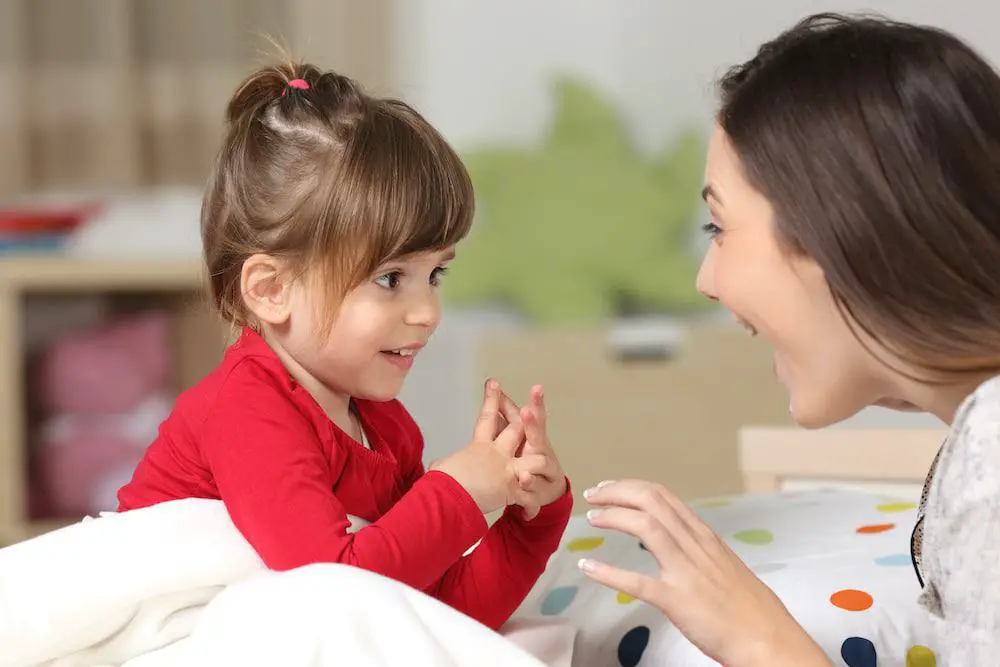The simplest expressive language definition relates to your child and how he communicates his thoughts and feelings.
It’s far more than putting words together to create incoherent sentences, and it’s a significant developmental milestone.
You can often use expressive language as a way to determine if your child requires speech therapy.
Expressive Language Definition
In this guide, we’ll not only define expressive language but help you notice its significant milestones.
Parents who wonder if their children have speech delays will surely need to take this factor into account.
What Is Expressive Language?
How your child uses language to express himself is the basic definition of expressive language.
It is how he communicates his thoughts, needs, and ideas, using sentences, words, or phrases.
It’s a rather broad term, which can then be broken down into three categories: morphology, semantics, and syntax.
Semantics
With expressive language semantics, specialists will look at the vocabulary of your child.
If the right words to explain himself don’t come to him easily, this falls under semantics. If he has a reduced vocabulary, this is also part of this category.
Syntax
When it comes to syntax, you’ll want to think about grammar. Most children showing difficulties with syntax will use much smaller sentences than expected.
Typically, if you compare their speech to their developmental milestones, their sentences are shorter than others their age.
Morphology
In morphology, specialists will look at how children use important grammatical pieces in their sentences.
For example, using “ing” at the end of words or possessives can be troublesome for those struggling with morphology.
Also referred to as morphemes, these essential pieces of grammatical language are necessary for adequate communication.
What Is an Example of Expressive Language?
One of the easiest ways to understand what we’re talking about is to ask, what is an example of expressive language?
Here are a few:
- I’m tired vs. Me tire
- I had a drink vs. Me drink
- I’m walking vs. I walk
Define Expressive Language Milestones
If you’ve been concerned that your child is dealing with an expressive language disorder, you need to consider milestones.
Milestones are in place to help you understand where your child’s development should be concerning their age.
It’s a general baseline to help parents determine whether it’s time to seek a professional’s help or not.
12 to 15 Months
Before 12 months of age, children will likely babble as the primary source of communication.
By 12 to 15 months, they should have spoken their first word at least, but there isn’t too much concern at this stage.
If your child hasn’t begun talking around 12 months, you shouldn’t be concerned, as some children just take a little longer to do so.
Related: How Many Words Should a 15 Month Old Say?
18 to 24 Months
By now, your child should have up to 100 words he can use in his expressive vocabulary. However, the total might differ, as some kids might have 50 words, and others over 100.
As he gets closer to 24 months, you should expect your child’s vocabulary to nearly double or triple in size.
Often, at least two years old, kids will have over 200 words they use regularly.
They will also begin using phrases that consist of two words, which shows the beginning of expressive language.
For example, your children might begin saying sentences like “go outside” or “we walk.”
Related: How Many Words Should A 20-Month-Old Say?
24 to 30 Months
With their speech development blossoming, 24 to 30 months is when you’ll begin to notice children using morphemes.
Their grammar markers will begin to be added to words so that they can create more understandable sentences.
Often, children will begin adding “ing” to the end of words, as well as using plurals and possessives.
You’ll begin to notice a significant improvement in their sentence formation as well as the length of their sentences.
However, it’s highly likely they’ll still make syntax errors quite often.
Three Years
The improvement in your child’s speech will skyrocket between two and three years.
By this age, they’ll begin using longer sentences, often over four words in length. They will also start to express their creative ideas and thoughts.
At three years, children will also become more inquisitive and begin asking more questions.
You’ll notice a significant improvement in inflection, such as adding a verbal question mark at the end of a question.
Color words and spatial concepts are also going to become more prevalent during this milestone.
In terms of vocabulary, they can have anywhere from 500 to 1,100 words available for communication.
Four to Five Years
At this stage, when your child speaks, most of his words should be correct. They’ll begin to use past tense words but might still make grammatical errors now and then.
Still, you should be able to see a significant improvement compared to their previous milestones.
At four to five years, your kids should be able to express their day and feelings. They should also be able to tell stories and use their imagination to be creative.
Often, strangers will be able to understand what they’re saying correctly.

Five to Seven Years
Between five and seven years of age, your child’s speech has significantly blossomed. His vocabulary likely increased to up to 5,000 words, and he can tell simple stories.
His sentences will also be able to tell stories in the correct order of how the events occurred. In necessary conversations, he can contribute his thoughts and opinions.
Overall, his expressive language has likely increased ten-fold and will continue to improve over the coming years.
Building Blocks to Expressive Language
As with other communication systems, many items go into the foundation of expressive language.
Your child will likely need all of the following to help develop his expressive language.
Pre-Language Skills
Pre-language skills will be most noticeable during the early months of their life, especially as a toddler.
Typically, children will begin to use facial expressions and gestures to signify that they need or want something.
They will also provide eye contact and pay attention to more than one thing at the same time.
Imitation is another significant part of pre-language skills. Although your child might not understand the words they’re using, they can imitate you.
Play Skills
By participating in activities voluntarily, children will be able to express their enjoyment and pleasure.
Some of these activities might not be goal-oriented, which makes them a form of socialization. With that said, play skills will need to be self-motivated.
Concentration
Being able to maintain a steady form of attention to tasks is another building block to expressive language.
Your children will need to show that they can provide a sustained effort to focus on something without distraction.
Also, they should be able to hold their concentration until the task is complete.
Language Comprehension
Even if your child isn’t able to express themselves, they should understand what others are saying.
Receptive language is key to being able to form your vocabulary and grammatical skills.
Pragmatics and Motivation
Not only are pragmatics important, but social motivation is, as well. In social situations, the way your child uses his language has everything to do with pragmatics.
However, he should also be interested in communicating with others on his own.
When children can develop their play skills, they can start to add to their communicative skills.
They will begin to label toys, interact with their peers, and understand the process of requesting things.
Also, pragmatics is essential for speech development, as it teaches children how to participate in conversations appropriately.
Activities to Help With Expressive Language
One of the best ways to assist your child with their expressive language is to try at-home activities.
There are several things that you can do at every milestone to help them acquire essential language skills.
Parent-Child Communication
The most important thing that you can do for your child is to communicate with them regularly.
Your child will start his language development by following his role models. You’ll want to begin asking him how his day is progressing and help to describe the things he can see.
It can also be beneficial to prompt your child to express his feelings and ask his questions.
At earlier milestones, he might not respond as effectively, but it teaches him the foundation of communication.
The more often you talk to him, the easier it will be for your child to begin imitating your speech.
Books and Puzzles
There are plenty of fun activities your child can use to his advantage, but books and puzzles are ideal.
With books, you can begin reading to them at a younger age, and as they get older, they can read to you.
Not only is this a fantastic way to increase their vocabulary, but it also boosts their imagination.
Puzzles are another fun activity because they’re goal-oriented. They are ideal for helping your child focus on a single task until it’s complete.
It’s also a unique way to have your kids refine their problem-solving skills.
Imitate Your Child’s Speech
Not only is it essential that your kids imitate your speech but that you do so, as well. However, instead of merely saying what they are saying, you can improve their grammar.
For example, if your child asks for a drink by saying, “Juice,” you could say, “I want juice, please.”
Related: Expressive Language Delay and How to Deal With It
What Is Expressive Language in Child Development?
The expressive language definition is simple, and it’s also necessary.
But what is expressive language in child development? What role does it play?
By knowing what milestones your child should be achieving when it comes to using language, you can help them develop their skills.
Also, it can assist parents with knowing when it’s time to seek professional assistance.

